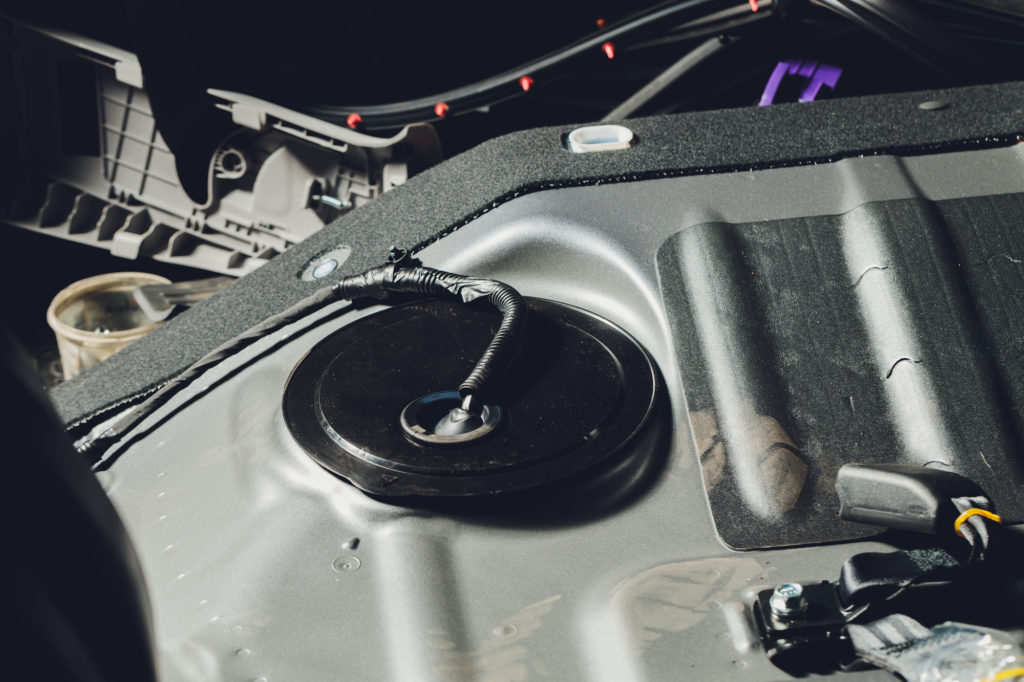A fuel pressure sensor is a small electronic device that measures the pressure of the fuel in the fuel line. The sensor is usually located near the fuel injectors or on the fuel pump. If the sensor malfunctions, it can cause the engine to run lean or rich, and may even cause stalling.
Replacing a fuel pressure sensor is typically a relatively simple and inexpensive repair.
A fuel pressure sensor is an important component in a vehicle’s fuel system. It monitors the pressure of the fuel in the system and sends a signal to the engine control unit (ECU). If the sensor detects a drop in pressure, it will trigger the ECU to adjust the fuel mixture accordingly.
The average cost for a Fuel Pressure Sensor Replacement is between $247 and $267. Labor costs are estimated between $132 and $167 while parts are priced at $115 . This range does not include taxes and fees, and does not factor in your specific vehicle or unique location.
Related repairs may also be needed.
Top 7 signs of bad fuel pressure Sensor [dr cool auto fix]
How Serious is a Fuel Pressure Sensor?
A fuel pressure sensor is a very important part of a vehicle’s fuel system. It is responsible for monitoring the pressure of the fuel in the system and sending a signal to the engine control unit (ECU) to adjust the fuel delivery accordingly. If the sensor is not working properly, it can cause serious problems with the engine, including reduced power, poor fuel economy, and even engine failure.
What are the Symptoms of a Bad Fuel Pressure Sensor?
If your car is having trouble starting, stalling, or running rough, it could be a sign of a bad fuel pressure sensor. Other symptoms include a check engine light, poor fuel economy, and misfiring. If you’re experiencing any of these issues, it’s important to get your car checked out by a mechanic to diagnose the problem.
Can You Drive With a Fuel Pressure Sensor?
A fuel pressure sensor is an important component in a vehicle’s fuel system. It helps to regulate the pressure of the fuel in the system, and it can also help to prevent fuel leaks. If your vehicle has a fuel pressure sensor, you should be able to drive with it without any problems.
However, if you notice that your vehicle’s fuel system is not working properly, or if you have any concerns about the safety of your vehicle, you should take it to a mechanic for inspection.
How Long Does a Fuel Pressure Sensor Last?
A fuel pressure sensor (FPS) is a device used to measure the pressure of the fuel in an engine. FPSs are typically located in the fuel line, between the fuel pump and the engine. They are often used in conjunction with a fuel pressure regulator to help maintain proper fuel pressure in the system.
FPSs can last for many years, but they are subject to wear and tear like any other component in a vehicle. Over time, they may become clogged or damaged, which can cause them to fail. Replacing a failed FPS is generally not a difficult or expensive task.

Credit: www.suctionvalves.com
How Long Does It Take to Replace a Fuel Pressure Sensor
If your car is having trouble starting, stalling, or running rough, it may be time to replace the fuel pressure sensor. This relatively simple task can be completed in about an hour, and will only require a few tools. Here’s a step-by-step guide to replacing your fuel pressure sensor:
1. Disconnect the negative battery cable. This will help prevent any accidental electrical shorts while you’re working on the sensor.
2. Locate the fuel pressure sensor.
It is usually mounted on the fuel rail, near the injectors. Consult your vehicle’s service manual for specific location information.
3. Disconnect the wiring harness from the sensor.
You may need to use a small pick or other tool to release the locking tab on the connector.
4 Use a wrench to loosen and remove the sensor from its mounting location. Be careful not to damage any of the surrounding components as you remove it.
5 Inspect the new sensor for any damage or debris that may have occurred during shipping or handling, and clean off any dirt or grime from its surface with a cloth .6 Install the new sensor in its mounting location ,and hand tighten it in place .7 Reconnect t he wiring harness ,and reattach t he negative battery cable .8 Start up your engine and check for proper operation . If all goes well ,you’ve successfully replaced your fuel pressure sensor !
Fuel Pump Sensor Cost
If your car is having trouble starting, or if the check engine light is coming on, it could be a problem with the fuel pump sensor. This important part of your car’s fuel system helps to regulate the flow of gasoline to the engine, and if it isn’t working properly, it can cause all sorts of problems.
The cost of replacing a fuel pump sensor will vary depending on the make and model of your car, but you can expect to pay anywhere from $100 to $200 for the parts and labor.
If you’re experiencing any issues with your car’s fuel system, it’s always best to take it to a qualified mechanic for diagnosis and repair.
Fuel Sensor Symptoms
If your car’s fuel sensor is malfunctioning, you may notice one or more of the following symptoms:
1. Your car’s mileage per gallon (MPG) decreases significantly.
2. Your car starts to experience engine knock.
3. You see an increase in exhaust emissions.
4. Your car’s engine stalls frequently.
5. Your check engine light comes on.
Where is the Fuel Tank Pressure Sensor Located
If your car is having issues with the fuel system, one part that may need to be checked is the fuel tank pressure sensor. This sensor is responsible for sending information about the pressure in the fuel tank to the engine control unit. If there is an issue with this sensor, it can cause problems with how the engine runs.
So, where is this important sensor located?
On most cars, the fuel tank pressure sensor will be located on top of the fuel tank. It is usually mounted on a bracket or stud so that it can screw into the side of the tank.
In some cases, it may be located on the bottom of the fuel tank or even inside of it. If you’re not sure where yours is located, consult your car’s owner’s manual or a mechanic.
Once you’ve found the sensor, you’ll need to remove it in order to test it (or replace it if necessary).
To do this, first disconnect any electrical connectors that are attached to it. Then, use a wrench to loosen and remove any bolts or screws holding it in place. With the sensor removed, you can now test its output using a multimeter set to measure AC voltage.
Fuel Rail Pressure Sensor
A fuel rail pressure sensor is a type of sensor that is used to measure the pressure of the fuel in the fuel rail. This sensor is usually located on the side of the engine near the fuel injectors. The purpose of this sensor is to provide information to the engine control unit (ECU) so that it can properly regulate the amount of fuel being injected into the engine.
There are two main types of fuel rail pressure sensors: analog and digital. Analog sensors work by measuring the voltage across a resistor, while digital sensors use a piezoelectric crystal to measure pressure. Both types of sensors are accurate, but digital sensors tend to be more expensive.
Fuel rail pressure sensors are important because they help ensure that engines run smoothly and efficiently. If an engine does not have enough pressure, it will not run correctly and could stall or even cause damage to the engine. Too much pressure can also cause problems, such as knocking or pinging sounds, poor acceleration, and reduced fuel economy.
If you suspect that your vehicle has a problem with its fuel rail pressure sensor, it is important to take it to a mechanic or dealership for diagnosis and repair.
Ram 1500 Fuel Sensor Replacement Cost
The Ram 1500 is a half-ton truck that was first introduced in 1994. It is currently in its fourth generation of production, which began in 2018. The Ram 1500 has been one of the most popular trucks on the market, and for good reason.
It’s a workhorse that can tow up to 12,750 pounds and haul up to 1,880 pounds. Plus, it’s comfortable and available with plenty of luxury features.
One thing you might not know about the Ram 1500 is that it has a fuel sensor that needs to be replaced every so often.
The cost of replacing the fuel sensor will vary depending on where you take your truck and which parts are needed. However, we’ve done some research and found that the average cost of a fuel sensor replacement for the Ram 1500 is between $200 and $300.
Fuel Rail Pressure Sensor Symptoms
If your check engine light is on, or you’re experiencing any of the following symptoms, it’s possible that you have a failing fuel rail pressure sensor:
1. Your engine is hard to start, or won’t start at all.
2. Your engine stalls frequently.
3. You experience reduced power when accelerating.
4. Your mileage has decreased significantly.
A failing fuel rail pressure sensor can cause all sorts of problems with your engine, so it’s important to get it checked out as soon as possible if you think there may be an issue.
If you’re not sure whether or not your car has a fuel rail pressure sensor, consult your owner’s manual or ask a mechanic; they’ll be able to tell you for sure and point you in the right direction for getting it repaired or replaced if necessary.
Fuel Pump Replacement Cost
If your car starts to have trouble starting up, or if the engine is sputtering and hesitating, it may be time to replace the fuel pump. Fuel pumps are responsible for delivering fuel from the tank to the engine, and over time they can wear out. Replacing a fuel pump is not a difficult job, but it can be expensive, depending on the make and model of your vehicle.
Here’s a look at what you can expect to pay for a fuel pump replacement:
On average, you will pay between $400 and $900 to replace a fuel pump. This includes parts and labor costs.
However, there are some factors that can influence the cost of this repair. For example, if your car has an in-tank fuel pump (which is common in newer vehicles), it will be more expensive to replace than an external fuel pump. Additionally, luxury vehicles tend to have more complicated fuel systems, which means higher labor costs for this repair.
Here are some examples of what people have recently paid forfuel pump replacements:
$600 – 2008 Honda Accord with an in-tank fuel pump
$700 – 2014 Audi A4 with an external fuel pump
$800 – 2016 BMW 328i with an in-tank fuel pump
Conclusion
The fuel pressure sensor is an important component of the fuel system in a vehicle. If the sensor fails, it can cause problems with the engine performance and fuel economy. Replacing a fuel pressure sensor can be expensive, depending on the make and model of the vehicle.

